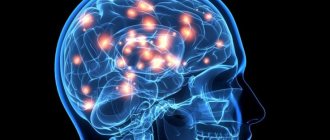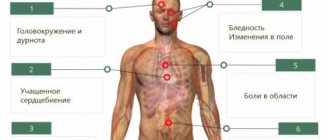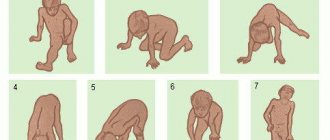Werdnig-Hoffmann genetic disease belongs to the group of spinal amyotrophies and is inherited in an autosomal recessive manner.
Spinal muscular atrophy (SMA) is characterized by congenital or acquired degenerative changes in the striated muscles, symmetrical muscle weakness of the trunk and limbs, absence or reduction of tendon reflexes while maintaining sensitivity.
Morphological studies reveal pathology of motor neurons of the spinal cord , “fascicle atrophy” in skeletal muscles with a characteristic alternation of affected fibers and healthy ones.
There is a violation of the conductive function of nerve fibers and a decrease in muscle contractility. Statistics
1 in 40-50 people is a carrier of the mutant SMN gene. The pathology occurs with a frequency of 1: 6,000 - 10,000 newborns.
Causes of the disease
The main cause of spinal amyotrophy of Werdnig Hoffmann is a mutation of the SMN gene (from the English survival motor neuron). The motor neuron survival gene is located on chromosome 5 and is represented by two copies:
- SMNt—telomeric copy, functionally active;
- SMNc is a centromeric copy of the gene, partially active.
The product of this gene is the SMN protein, which is involved in the formation and regeneration of RNA.
Lack of protein causes motor neuron pathologies.
In 95% of cases of Werdnig-Hoffmann disease, there is a deletion (loss) of SMNt, which causes a deficiency of the SMN protein. The SMNc copy only partially compensates for the lack of a telomeric copy.
The copy number of SMNc ranges from 1 to 5. The greater the number of centromeric copies, the more complete the protein is reproduced and the less pronounced the neuron pathology.
In addition to the number of copies of SMNc, the severity of the disease is determined by the length of the deletion site and gene conversions of 3 more genes: NAIP, H4F5, GTF2H2. The involvement of additional modifying factors explains the clinical variability of symptoms.
Types and symptoms
The disease spinal amyotrophy is divided by doctors and scientists into several types, differing in the degree of progression of the pathological course, the age of the patient, the severity of the disease and its clinical signs, as well as life expectancy.
It should be noted that in the clinical picture there are always no disturbances affecting the sensitive and mental spheres, just as the functions of the pelvic organs are not affected. Spinal muscular atrophy affects only the motor sphere; this is what differs the clinical picture of each type of pathology.
As for the principle of division, doctors distinguish 4 forms of the disease; for a full understanding, it is worth considering each separately.
1 form
This type of pathological process is often called infantile, as it is diagnosed in newborns from the first days of life until 6 months. The first form is considered the most malignant due to the age of the person, as well as the rate of progression and damage caused to the body.
Regarding the clinical picture, it is varied:
- Swallowing and sucking reflexes are disrupted, which is accompanied by defective motor skills of the tongue. Spontaneous and uncontrolled muscle contractions are noticeable on the tongue; they are called fisculations; the organ is atrophied. Due to impaired swallowing reflex during feeding, mother's milk may enter the respiratory tract.
- At this age, a characteristic symptom will be respiratory failure caused by a violation of the contractile functions of the diaphragmatic and intercostal muscles. There is a delay in the development of motor skills, the child is unable to roll over on his own, hold his head up, there is no grasping reflex, and in the future the baby will not be able to sit.
- Often, in the first form of the pathological process, deformation of the bones of the chest occurs, it becomes asymmetrical, it can be sunken or bulging.
The development of pathology from the first days of life leads to the fact that most children do not live to see 6 months.
2 form
Another form of early manifestation of spinal amyotrophy, which is considered to be intermediate. Until six months, the child does not show any signs of the disease; the pathological process is diagnosed between the sixth month and the second year of the baby’s life.
The second form of the disease is characterized by a gradual increase in symptoms:
- First of all, tendon reflexes are lost.
- The process of walking worsens, if by the time the disease begins he has already learned to walk, soon the skill is completely lost.
- As the disease progresses, muscle tissue atrophy affects all limbs.
- Soon the child stops holding his head up and tremor of the limbs is noticed.
- Often in this case, the pathology is accompanied by severe forms of osteoarticular anomalies, scoliosis of the spine, dislocations of the knee and hip joints, etc.
In both the first and second forms of the disease, respiratory failure develops. However, the life prognosis in this case is more favorable. With appropriate treatment, children overcome adolescence and, depending on the situation, live up to 20-30 years.
3 form
This type of disease, also called Kugelberg-Welander spinal amyotrophy, is diagnosed in older children between the second and fifteenth years of life.
The clinical picture in this case is as follows:
- The first sign is impaired walking. The child often stumbles, wobbles, steps become unsteady, the same muscle atrophy is to blame, and later the skill is lost.
- As in the previous case, after some time the disease also affects the upper limbs.
- Facial muscles are affected, facial expressions are affected, which is not observed in previous forms of pathology.
- Various skeletal deformities are again observed.
With the pathology of spinal atrophy of the third form, taking into account the support of drug therapy, patients live up to 40 years on average.
4 form
Kennedy's bulbospinal amyotrophy or the adult form of the disease, which begins after 35 years of life in the presence of the previously mentioned damaged chromosome in the body.
According to statistics, this type of syndrome is the most favorable, if one can even say so. The pathology develops slowly, but as it progresses, the following clinical signs of the disease appear:
- Decreased reflex functions.
- Muscle weakness in the limbs.
- Large-scale muscle atrophy in different parts of the body.
- By the end of life, a complete decrease in motor functions may be detected.
- It is noteworthy that the respiratory process in this case is not disturbed.
The life of patients with the fourth form of the pathological process is as long as that of healthy people.
Symptoms of the disease
SMA 1 and SMA 2 have different symptoms and signs.
What are the long-term consequences of a traumatic brain injury and how to protect yourself as much as possible from getting a head injury.
Rupture of the veins and vessels of the brain provokes a disease such as subdural hematoma of the brain. What is the difficulty of treating and diagnosing the disease?
Form of spinal amyotrophy Werdnig SMA 1
The first symptoms are detected during pregnancy by weak fetal movements.
Photo: spinal amyotrophy of Werdnig Hoffmann
From birth, children experience respiratory failure and congenital spinal amyotrophy of Werdnig Hoffmann :
- low muscle tone, the child cannot hold his head up and cannot roll over;
- lack of reflexes;
- disturbances in sucking, swallowing, twitching of the tongue, fingers, weak crying.
Article on the topic: Bronchial asthma in children - symptoms and treatment, disease prevention
The baby takes a characteristic “frog” pose with arms and legs bent at the joints, lying on his stomach. In SMA 1, partial paralysis of the diaphragm - Cofferat syndrome.
The phenomenon is characterized by difficulty breathing, shortness of breath, cyanosis.
On the side of paralysis, there is a bulging of the chest, and the risk of pneumonia increases.
In infants, deformations of the skeletal system are observed, expressed in limited joint mobility, the appearance of scoliosis, and changes in the shape of the chest.
SMA form 2
In the first months of life, children develop normally: they begin to hold their heads, sit, and stand on time.
After 6 months the first symptoms , usually after an acute respiratory or food infection.
First of all, the limbs are affected , especially the legs, and tendon reflexes are reduced.
Then the muscles of the torso and arms, intercostal muscles, and the diaphragm are gradually involved in the process, which causes deformation of the chest. The gait changes, acquiring a resemblance to a “wind-up doll.”
Children become awkward and often fall. Twitching of the tongue and trembling of the fingers are observed.
What is Werdnig-Hoffmann amyotrophy?
Spinal amyotrophy type 1 or, in other words, Werdnig-Hoffmann spinal amyotrophy
is a special disease of the nervous system that is inherited (most often from both parents). This pathology is characterized by the presence of muscle weakness in almost the entire muscular system of the body. A child suffering from such a disease cannot sit, move or care for himself independently.
Unfortunately, there is no cure for this type of disease in the world. The maximum that doctors can offer in our time is prenatal diagnosis. Such an examination helps to avoid the birth of a sick baby in the family.
Pathology received its name from two scientists who first described it at the end of the 19th century. Currently, the concept of spinal amyotrophy refers to several forms of the disease that differ clinically. But they are all connected by the same genetic defect that the child’s parents have.
Clinical picture of the disease
Spinal amyotrophy has several forms and varieties
, each of which differs in the age of onset of characteristic symptoms, the severity of the disease and the life expectancy of patients.
usually leads to disability
, since the motor system of the body is disrupted, and the patient is unable to move independently or take care of himself. In severe clinical situations, constant medical supervision may be required in everyday life.
Wheelchairs, walkers, crutches, and canes help such a patient move. Such a disease can lead to death only when complications arise from the respiratory and cardiovascular systems (pneumonia and heart failure).
Sensitive nerve fibers are not affected by pathology
, so the child retains all types of sensitivity. Intelligence and mental functions also do not suffer, so when learning, the child perceives and assimilates information completely normally.
Classification of the disease
Depending on the age at which the characteristic symptoms of the disease appeared, Werdnig-Hoffmann amyotrophy is divided into several types:
- Congenital form of pathology
. Approximate age of onset of changes: from 0 to 6 months. Usually characterized by weak intrauterine movement of the fetus. In the congenital form, muscle hypotonia is observed from the first days of the baby’s life. Within a short time, deep reflexes fade away: the child screams weakly, sucks poorly on mother's milk or pacifier, and cannot hold his head up. Sometimes it happens that these symptoms appear a little later, so the baby may learn to hold up his head and sit, but because there is a disorder, he will not develop these skills. Also, the congenital form may be accompanied by bulbar disorders, decreased pharyngeal reflex and fascicular twitching of the tongue. The congenital form is considered the most malignant and can often combine mental retardation, chest deformities, and 4 degrees of scoliosis. Rapid immobility and paresis of the respiratory system leads to respiratory failure and subsequently death; - Early childhood form.
With this type of pathology, the first symptoms may appear after 6 months. At this point, children have normal physical and mental development. They begin to slowly acquire the first natural skills, such as the ability to hold their heads, stand, sit down and roll over. In most cases, with this type of disease, children never learn to walk. At the initial stage, paresis occurs in the lower extremities, then quite quickly they develop in the upper extremities and throughout the entire musculature. Muscular hypotonia sets in, deep reflexes fade, finger tremors and involuntary muscle contractions may appear. At later stages, bulbar disorders and respiratory failure (progressive) are added to all symptoms. This form of the disease progresses more slowly than the congenital type. Patients can live up to 15 years; - Kugelberg-Welander amyotrophy.
The most benign of all forms of spinal amyotrophy. Symptoms appear after 2 years, sometimes between 15 and 30 years. With this form, mental developmental delay does not occur; patients are able to move independently for quite a long time. Many live to a ripe old age with complete self-care.
Diagnostics
For Verdnik's spinal amyotrophy, diagnosis consists of genetic analysis, identifying mutations or deletions of the SMN gene.
If a deletion of the telomeric copy of SMNt is detected, the diagnosis is considered confirmed.
If there is no deletion, additional studies are carried out:
- electroneuromyography;
- nerve conduction study;
- creatine kinase test;
- biopsy of muscles and nerve tissue.
If creatine kinase enzyme levels are normal, SMNc copies are counted. In the case of a single copy, the point mutation is identified to make the final decision.
Differential diagnosis
Similar symptoms are observed with congenital myopathy - a violation of muscle tone.
The results of a biopsy can completely exclude muscle hypotonia.
Acute poliomyelitis has a certain similarity with Werdnig-Hoffmann disease. It begins violently, with a sharp rise in temperature and asymmetrical multiple paralysis.
The acute period lasts for several days, then the process moves into the recovery stage.
Glycogenosis and congenital myopathies are also characterized by decreased muscle tone. The changes are caused, in contrast to spinal muscular amyotrophy, by metabolic disorders, carcinoma, and hormonal imbalance. Gaucher disease, Down syndrome, and botulism should also be excluded.
Helping organizations
The SMA Families Charitable Foundation is the only organization in Russia that specializes in helping families dealing with spinal muscular atrophy. It provides charitable, informational and psychological support to families, and advises specialists on the disease and methods of working with patients with SMA.
Hospice Assistance Fund "Vera". Charitable and advisory assistance to families with terminally ill children and terminally ill adults.
CSCH No. 1 Department of palliative care for children, Yekaterinburg, Sverdlovsk region. Medical, informational, social and psychological assistance is provided to families raising a disabled child with a palliative condition.
“Research Clinical Institute of Pediatrics named after Academician Yu.E. Veltishchev” FSBEI AT RNRMU named after N.I. Pirogov. The institute is located in Moscow. Residents throughout Russia can seek medical help for children with SMA and other neuromuscular diseases.
Clinic "Chaika". Consultations with pulmonologist Vasily Andreevich Shtabnitsky for children and adults with SMA.
Children's hospice “House with a Lighthouse” (Moscow, near Moscow region). Medical, psychological, legal, social, and charitable assistance to families with terminally ill children and young adults (up to 25 years of age).
Marfo-Mariinsky Medical Center (Moscow). Medical, psychological, legal assistance, nanny assistance, events, spiritual support, charitable assistance to families with terminally ill children.
You will find more detailed information on the website of the SMA Families charity foundation and their special project about life with spinal muscular atrophy
The special project is intended for those who have been diagnosed with SMA and would like to know all the most important things about this disease: which specialists and where to go, how to care, what to watch for, what to remember, what therapy exists today.
To study Tips for treating displacement of the lumbar vertebrae
Treatment methods
Treatment of spinal amyotrophy is symptomatic and aimed at stabilizing the patient's condition.
Medicines prescribed :
- improving metabolism - cerebrolysin, lipocerebin, aminalon;
- affecting the trophism of muscle tissue - potassium orotate, glutamic acid, methionine, tocopherol acetate;
- promoting neuromuscular conduction - prozerin, galantamine, dibazol;
- stimulating blood circulation in capillaries - complamin, nicotinic acid;
- supporting the viability of motor neurons - valproic acid, riluzole, L-carnitine.
Article on the topic: Tablets for tachycardia and palpitations
Patients are prescribed orthopedic procedures in combination with warm baths, therapeutic exercises, gentle massage, oxygen therapy, and sulfide baths are indicated.
Types of spinal amyotrophies
Conventionally, proximal and distal forms of SMA are distinguished. 80% of all types of spinal amyotrophy are of the proximal form.
These include, in addition to Werdnig-Hoffmann disease:
- SMA 3 or Kuldberg-Welander - occurs between the ages of 2 and 20, and the pelvic muscles are the first to suffer. There is tremor of the hands and lordosis.
- Lethal X-linked form - described in 1994 by Baumbach, is inherited in a recessive manner, predominantly affecting the muscles of the pelvis and shoulder girdle.
- Infantile degeneration - reflexes of sucking, swallowing, breathing are impaired. Death may occur before the age of 5 months.
- SPA Ryukyu - the linkage gene has not been identified, there is a lack of reflexes, muscle weakness of the limbs after birth.
This group also includes Norman's disease, SMA with congenital arthrogryposis, SMA with congenital fractures.
Distal spinal amyotrophies include progressive Fazio-Londe paralysis, Brown-Vialetta-van Laere disease, SMA with diaphragmatic paralysis, epilepsy and oculomotor disorders.
How is the diagnosis made?
To detect the disease in utero, amniotic fluid is collected
Werdnig-Hoffmann spinal muscular atrophy can be detected before or after the baby is born. Prenatal diagnosis is based on identifying a genetic defect. This requires obtaining the baby's genetic material from umbilical cord blood, amniotic fluid or chorionic villi. Invasive diagnostic methods are dangerous for the development of pregnancy, so parents often refuse them. If pathology is detected, this is an indication for abortion.
The birth of children with Werdnig-Hoffmann spinal muscular atrophy (SMA) is possible for several reasons. Not all hospitals have the opportunity for prenatal diagnosis of the disease and genetic counseling for parents before conceiving a baby. Parents carry out the analysis mainly at their own request and may not know until the moment of birth that the baby will be seriously ill. Sometimes the diagnosis is made at a late stage, when it is too late to terminate the pregnancy. The fundamental opposition to abortion among some parents also plays a role - even knowing about the future pathology, they decide to give birth.
After birth, the diagnosis is made by a neonatologist or pediatric neurologist. The neurological status of a small patient is important - impaired motor activity and extinction of reflexes while maintaining sensitivity. To make a final diagnosis, a DNA test is prescribed. MRI and CT scans of the spine are important to distinguish SMA from other pathologies. Disturbances in the motor nuclei of the spinal cord are not visualized.











